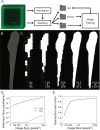Automated, high-throughput quantification of EGFP-expressing neutrophils in zebrafish by machine learning and a highly-parallelized microscope
- PMID: 38060605
- PMCID: PMC10703246
- DOI: 10.1371/journal.pone.0295711
Automated, high-throughput quantification of EGFP-expressing neutrophils in zebrafish by machine learning and a highly-parallelized microscope
Abstract
Normal development of the immune system is essential for overall health and disease resistance. Bony fish, such as the zebrafish (Danio rerio), possess all the major immune cell lineages as mammals and can be employed to model human host response to immune challenge. Zebrafish neutrophils, for example, are present in the transparent larvae as early as 48 hours post fertilization and have been examined in numerous infection and immunotoxicology reports. One significant advantage of the zebrafish model is the ability to affordably generate high numbers of individual larvae that can be arrayed in multi-well plates for high throughput genetic and chemical exposure screens. However, traditional workflows for imaging individual larvae have been limited to low-throughput studies using traditional microscopes and manual analyses. Using a newly developed, parallelized microscope, the Multi-Camera Array Microscope (MCAM™), we have optimized a rapid, high-resolution algorithmic method to count fluorescently labeled cells in zebrafish larvae in vivo. Using transgenic zebrafish larvae, in which neutrophils express EGFP, we captured 18 gigapixels of images across a full 96-well plate, in 75 seconds, and processed the resulting datastream, counting individual fluorescent neutrophils in all individual larvae in 5 minutes. This automation is facilitated by a machine learning segmentation algorithm that defines the most in-focus view of each larva in each well after which pixel intensity thresholding and blob detection are employed to locate and count fluorescent cells. We validated this method by comparing algorithmic neutrophil counts to manual counts in larvae subjected to changes in neutrophil numbers, demonstrating the utility of this approach for high-throughput genetic and chemical screens where a change in neutrophil number is an endpoint metric. Using the MCAM™ we have been able to, within minutes, acquire both enough data to create an automated algorithm and execute a biological experiment with statistical significance. Finally, we present this open-source software package which allows the user to train and evaluate a custom machine learning segmentation model and use it to localize zebrafish and analyze cell counts within the segmented region of interest. This software can be modified as needed for studies involving other zebrafish cell lineages using different transgenic reporter lines and can also be adapted for studies using other amenable model species.
Copyright: © 2023 Efromson et al. This is an open access article distributed under the terms of the Creative Commons Attribution License, which permits unrestricted use, distribution, and reproduction in any medium, provided the original author and source are credited.
Conflict of interest statement
The authors declare the following financial interests/personal relationships which may be considered as potential competing interests: AB, TJJD, CD, JE, MH, PR, and VS are employees of, have a financial interest in, and contribute intellectual property to Ramona Optics Inc., which is commercializing the multicamera array microscope. This does not alter our adherence to PLOS ONE policies on sharing data and materials.
Figures




Update of
-
Automated, high-throughput quantification of EGFP-expressing neutrophils in zebrafish by machine learning and a highly-parallelized microscope.bioRxiv [Preprint]. 2023 Aug 18:2023.08.16.553550. doi: 10.1101/2023.08.16.553550. bioRxiv. 2023. Update in: PLoS One. 2023 Dec 7;18(12):e0295711. doi: 10.1371/journal.pone.0295711. PMID: 37645798 Free PMC article. Updated. Preprint.
References
-
- Burn GL, Foti A, Marsman G, Patel DF, Zychlinsky A. The Neutrophil. Immunity. 2021;54: 1377–1391. - PubMed
MeSH terms
Grants and funding
LinkOut - more resources
Full Text Sources

